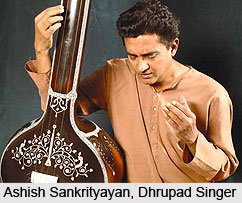 Forms of Hindustani music are quite a few in numbers. At present, in context of Hindustani or North Indian classical music, Dhrupad and Khayal are the two main styles of compositional and singing forms which are prevalent in north India. Thumri, Tappa etc constitutes the light classical music. Apart from these, there are devotional songs known as Bhajan and Kirtan whereas light lyrical music comprise of Geeta, Ghazal. Folk songs such as Kajari, Chaitis etc are also widely practised in north India. Each form of Hindustani music has its own unique yet enchanting features which have earned them prominence in music arena.
Forms of Hindustani music are quite a few in numbers. At present, in context of Hindustani or North Indian classical music, Dhrupad and Khayal are the two main styles of compositional and singing forms which are prevalent in north India. Thumri, Tappa etc constitutes the light classical music. Apart from these, there are devotional songs known as Bhajan and Kirtan whereas light lyrical music comprise of Geeta, Ghazal. Folk songs such as Kajari, Chaitis etc are also widely practised in north India. Each form of Hindustani music has its own unique yet enchanting features which have earned them prominence in music arena.
Dhrupad
Dhrupad was firstly invented and patronized by Raja Manshingh Tomar of Gwalior (1486-1526 A.D.). As the name indicates, Dhrupad is a strict style. Rhythmic movement and procedure by determinate degrees are the two known principles of this style which the performer strictly abides. There are four structural sections of Dhrupad. Asthayi or Sthayi forms the basic and first part while the Antara forms the second section and moves in the middle and higher octaves. In the succeeding two sections namely Samcharee and Abhog, compositional intricacies and the complexities of raaga further developed.
Dhamar
Dhamar finds similarity with Dhrupad but it is less grave in melodic progression. This style of singing mainly depicts the play of Lord Krishna, especially in the festival of colours (Holi) through its literary content. Often the texts are also erotic in nature. Tempo of Dhamar is a little faster than Dhrupad. The similarity of both the forms lies in performing the similar procedures of improvisation consisting of rhythmic pattern. Dhamar of fourteen Matras is known as Tala and otherwise it is known as Hori.
Khayal
One of the most common and popular musical art of northern India is Khayal. It has two parts namely Sthayi (or Asthayi) and Antara. The two kinds of Khayal include Chhota Khayal and Bada Khayal (the small and big Khayal). Usually while performing, a Bada Khayal is followed by a Chhota Khayal in the same raaga, though not necessarily in the same Tala.
Tarana
Alap-syllables, viz. Nom-Tom, etc are the main components of Tarana. In a Tarana the emphasis is laid on the tonal values and the literary or the poetic merit of words is completely ignored. Thus in a sense it is an ideal form of pure musical expression. In a Dhurupad, the prelude is formed by Alaps which are given to a very slow time and employ no fixed time-measure as such. A refined form of such Alaps is a Tarana as it is sung to a fixed measure of time. It is further developed as an independent song in which the tones, instead of words, speak. Tarana is appealing without the aid of poetry and is a composition which is performed in a strict measure of time. Tarana thus serves as a training ground in acquiring facility in Taans and particularly in Boltaans, stretching over a fixed interval of time. Tarana forms an excellent key for a good finish to the voice-training method as it has the ability to bring out the vowels and consonants effectively.
Saadra
Saadra is another compositional form which is set in Jhaptal, a Tala of ten beats. It is composed in the Braj Bhasha and is sung by both Dhrupad and Khayal singers.




















